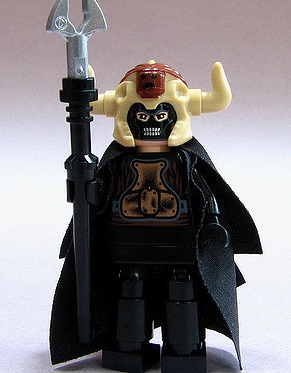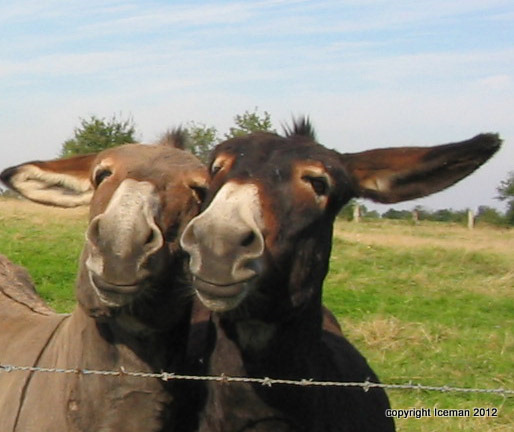Archive for the ‘Level 5 Courage’ Category
Dissent Without Reprisal – a key to company longevity
 In strategic planning there’s a strong forcing function that causes the organization to converge on a singular, company-wide approach. While this convergence can be helpful, when it’s force is absolute it stifles new ideas. The result is an operating plan that incrementally improves on last year’s work at the expense of work that creates new businesses, sells to new customers and guards against the dark forces of disruptive competition. In times of change convergence must be tempered to yield a bit of diversity in the approach. But for diversity to make it into the strategic plan, dissent must be an integral (and accepted) part of the planning process. And to inject meaningful diversity the dissenting voice must be as load as the voice of convergence.
In strategic planning there’s a strong forcing function that causes the organization to converge on a singular, company-wide approach. While this convergence can be helpful, when it’s force is absolute it stifles new ideas. The result is an operating plan that incrementally improves on last year’s work at the expense of work that creates new businesses, sells to new customers and guards against the dark forces of disruptive competition. In times of change convergence must be tempered to yield a bit of diversity in the approach. But for diversity to make it into the strategic plan, dissent must be an integral (and accepted) part of the planning process. And to inject meaningful diversity the dissenting voice must be as load as the voice of convergence.
It’s relatively easy for an organization to come to consensus on an idea that has little uncertainty and marginal upside. But there can be no consensus, but on an idea with a high degree of uncertainty even if the upside is monumental. If there’s a choice between minimizing uncertainty and creating something altogether new, the strategic process is fundamentally flawed because the planning group will always minimize uncertainty. Organizationally we are set up to deliver certainty, to make our metrics and meet our timelines. We have an organizational aversion to uncertainty, and, therefore, our organizational genetics demand we say no to ideas that create new business models, new markets and new customers. What’s missing is the organizational forcing function to counterbalance our aversion to uncertainty with a healthy grasping of it. If the company is to survive over the next 20 years, uncertainty must be injected into our organizational DNA. Organizationally, companies must be restructured to eliminate the choice between work that improves existing products/services and work that creates altogether new markets, customers, products and services.
When Congress or the President wants to push their agenda in a way that is not in the best long term interest of the country, no one within the party wants to be the dissenting voice. Even if the dissenting voice is right and Congress and the President are wrong, the political (career) implications of dissent within the party are too severe. And, organizationally, that’s why there’s a third branch of government that’s separate from the other two. More specifically, that’s why Justices of the Supreme Court are appointed for life. With lifetime appointments their dissenting voice can stand toe-to-toe with the voice of presidential and congressional convergence. Somehow, for long-term survival, companies must find a way to emulate that separation of power and protect the work with high uncertainty just as the Justices protect the law.
The best way I know to protect work with high uncertainty is to create separate organizations with separate strategic plans, operating plans and budgets. In that way, it’s never a decision between incremental improvement and discontinuous improvement. The decision becomes two separate decisions for two separate teams: Of the candidate projects for incremental improvement, which will be part of team A’s plan? And, of the candidate projects for discontinuous improvement, which will become part of team B’s plan?
But this doesn’t solve the whole challenge because at the highest organizational level, the level that sits above Team A and B, the organizational mechanism for dissent is missing. At this highest level there must be healthy dissent by the board of directors. Meaningful dissent requires deep understanding of the company’s market position, competitive landscape, organizational capability and capacity, the leading technology within the industry (the level, completeness and maturity), the leading technologies in adjacent industries and technologies that transcend industries (i.e., digital). But the trouble is board members cannot spend the time needed to create deep understanding required to formulate meaningful dissent. Yes, organizationally the board of directors can dissent without reprisal, but they don’t know the business well enough to dissent in the most meaningful way.
In medieval times the jester was an important player in the organization. He entertained the court but he also played the role of the dissenter. Organizationally, because the king and queen expected the jester to demonstrate his sharp wit, he could poke fun at them when their ideas didn’t hang together. He could facilitate dissent with a humorous play on a deadly serious topic. It was delicate work, as one step too far and the jester was no more. To strike the right balance the jester developed deep knowledge of the king, queen and major players in the court. And he had to know how to recognize when it was time to dissent and when it was time to keep his mouth shut. The jester had the confidence of the court, knew the history and could see invisible political forces at play. The jester had the organizational responsibility to dissent and the deep knowledge to do it in a meaningful way.
Companies don’t need a jester, but they do need a T-shaped person with broad experience, deep knowledge and the organizational status to dissent without reprisal. Maybe this is a full time board member or a hired gun that works for the board (or CEO?), but either way they are incentivized to dissent in a meaningful way.
I don’t know what to call this new role, but I do know it’s an important one.
Image credit – Will Montague
If you don’t know the critical path, you don’t know very much.
 Once you have a project to work on, it’s always a challenge to choose the first task. And once finished with the first task, the next hardest thing is to figure out the next next task.
Once you have a project to work on, it’s always a challenge to choose the first task. And once finished with the first task, the next hardest thing is to figure out the next next task.
Two words to live by: Critical Path.
By definition, the next task to work on is the next task on the critical path. How do you tell if the task is on the critical path? When you are late by one day on a critical path task, the project, as a whole, will finish a day late. If you are late by one day and the project won’t be delayed, the task is not on the critical path and you shouldn’t work on it.
Rule 1: If you can’t work the critical path, don’t work on anything.
Working on a non-critical path task is worse than working on nothing. Working on a non-critical path task is like waiting with perspiration. It’s worse than activity without progress. Resources are consumed on unnecessary tasks and the resulting work creates extra constraints on future work, all in the name of leveraging the work you shouldn’t have done in the first place.
How to spot the critical path? If a similar project has been done before, ask the project manager what the critical path was for that project. Then listen, because that’s the critical path. If your project is similar to a previous project except with some incremental newness, the newness is on the critical path.
Rule 2: Newness, by definition, is on the critical path.
But as the level of newness increases, it’s more difficult for project managers to tell the critical path from work that should wait. If you’re the right project manager, even for projects with significant newness, you are able to feel the critical path in your chest. When you’re the right project manager, you can walk through the cubicles and your body is drawn to the critical path like a divining rod. When you’re the right project manager and someone in another building is late on their critical path task, you somehow unknowingly end up getting a haircut at the same time and offering them the resources they need to get back on track. When you’re the right project manager, the universe notifies you when the critical path has gone critical.
Rule 3: The only way to be the right project manager is to run a lot of projects and read a lot. (I prefer historical fiction and biographies.)
Not all newness is created equal. If the project won’t launch unless the newness is wrestled to the ground, that’s level 5 newness. Stop everything, clear the decks, and get after it until it succumbs to your diligence. If the product won’t sell without the newness, that’s level 5 and you should behave accordingly. If the newness causes the product to cost a bit more than expected, but the project will still sell like nobody’s business, that’s level 2. Launch it and cost reduce it later. If no one will notice if the newness doesn’t make it into the product, that’s level 0 newness. (Actually, it’s not newness at all, it’s unneeded complexity.) Don’t put in the product and don’t bother telling anyone.
Rule 4: The newness you’re afraid of isn’t the newness you should be afraid of.
A good project plan starts with a good understanding of the newness. Then, the right project work is defined to make sure the newness gets the attention it deserves. The problem isn’t the newness you know, the problem is the unknown consequence of newness as it ripples through the commercialization engine. New product functionality gets engineering attention until it’s run to ground. But what if the newness ripples into new materials that can’t be made or new assembly methods that don’t exist? What if the new materials are banned substances? What if your multi-million dollar test stations don’t have the capability to accommodate the new functionality? What if the value proposition is new and your sales team doesn’t know how to sell it? What if the newness requires a new distribution channel you don’t have? What if your service organization doesn’t have the ability to diagnose a failure of the new newness?
Rule 5: The only way to develop the capability to handle newness is to pair a soon-to-be great project manager with an already great project manager.
It may sound like an inefficient way to solve the problem, but pairing the two project managers is a lot more efficient than letting a soon-to-be great project manager crash and burn. After an inexperienced project manager runs a project into the ground, what’s the first thing you do? You bring in a great project manager to get the project back on track and keep them in the saddle until the product launches. Why not assume the wheels will fall off unless you put a pro alongside the high potential talent?
Rule 6: When your best project managers tell you they need resources, give them what they ask for.
If you want to deliver new value to new customs there’s no better way than to develop good project managers. A good project manager instinctively knows the critical path; they know how the work is done; they know to unwind situations that needs to be unwound; they have the personal relationships to get things done when no one else can; because they are trusted, they can get people to bend (and sometimes break) the rules and feel good doing it; and they know what they need to successfully launch the product.
If you don’t know your critical path, you don’t know very much. And if your project managers don’t know the critical path, you should stop what you’re doing, pull hard on the emergency break with both hands and don’t release it until you know they know.
Image credit – Patrick Emerson
Battling the Dark Arts of Productivity and Accountability
 How did you get to where you are? Was it a series of well-thought-out decisions or a million small, non-decisions that stacked up while you weren’t paying attention? Is this where you thought you’d end up? What do you think about where you are?
How did you get to where you are? Was it a series of well-thought-out decisions or a million small, non-decisions that stacked up while you weren’t paying attention? Is this where you thought you’d end up? What do you think about where you are?
It takes great discipline to make time to evaluate your life’s trajectory, and with today’s pace it’s almost impossible. Every day it’s a battle to do more than yesterday. Nothing is good enough unless it’s 10% better than last time, and once it’s better, it’s no longer good enough. Efficiency is worked until it reaches 100%, then it’s redefined to start the game again. No waste is too small to eliminate. In business there’s no counterbalance to the economists’ false promise of never-ending growth, unless you provide it for yourself.
If you make the time, it’s easy to plan your day and your week. But if you don’t make the time, it’s impossible. And it’s the same for the longer term – if you make the time to think about what you want to achieve, you have a better chance of achieving it – but it’s more difficult to make the time. Before you can make the time to step back and take look at the landscape, you’ve got to be aware that it’s important to do and you’re not doing it.
Providing yourself the necessary counterbalance is good for you and your family, and it’s even better for business. When you take a step back and slow your pace from sprint to marathon, you are happier and healthier and your work is better. When scout the horizon and realize you and your work are aligned, you feel better about the work and, therefore, you feel better about yourself. You’re a better person, partner and parent. And your work is better. When the work fits, everything is better.
Sometimes, people know their work doesn’t fit and purposefully don’t take a step back because it’s too scary to acknowledge there’s a problem. But burying your head doesn’t fix things. If you know you’re out of balance, the best thing to do is admit it and start a dialog with yourself and your boss. It won’t get better immediately, but you’ll feel better immediately. But most of the time, people don’t make time to take a step back because of the blistering pace of the work. There’s simply no time to think about the future. What’s missing is a weapon to battle the black arts of productivity and accountability.
The only thing powerful enough to counterbalance the forces of darkness is the very weapon we use to create the disease of hyper-productivity – the shared calendar (MS Calendar, Google Calendar). Open up the software, choose your day, choose your time and set up a one hour weekly meeting with yourself. Attendees: you. Agenda: take a couple deep breaths, relax and think. Change your settings so no one can see the meeting title and agenda and choose the color that makes people think the meeting is off-site. With your time blocked, you now have a reason to say no to other meetings. “Sorry, I can’t attend. I have a meeting.”
This simple mechanism is all you need.
No more excuses. Make the time for yourself. You’re worth it.
image credit :jovian (image modified)
Doing New Work
 If you know what to do, do it. But if you always know what to do, do something else. There’s no excitement in turning the crank every-day-all-day, and there’s no personal growth. You may be getting glowing reviews now, but when your process is documented and becomes standard work, you’ll become one of the trivial many that follow your perfected recipe, and your brain will turn soggy.
If you know what to do, do it. But if you always know what to do, do something else. There’s no excitement in turning the crank every-day-all-day, and there’s no personal growth. You may be getting glowing reviews now, but when your process is documented and becomes standard work, you’ll become one of the trivial many that follow your perfected recipe, and your brain will turn soggy.
If you want to do the same things more productively, do continuous improvement. Look at the work and design out the waste. I suggest you look for the waiting and eliminate it. (One hint – look for people or parts queueing up and right in front of the pile you’ll find the waste maker.) But if you always eliminate waste, do something else. Break from the minimization mindset and create something new. Maximize something. Blow up the best practice or have the courage to obsolete your best work. In a sea of continuous improvement, be the lighthouse of doing new.
When you do something for the first time, you don’t know how to do it. It’s scary, but that’s just the feeling you want. The cold feeling in your chest is a leading indicator of personal growth. (If you don’t have a sinking feeling in your gut, see paragraph 1.) But organizations don’t make it easy to do something for the first time. The best approach is to start small. Try small experiments that don’t require approval from a budget standpoint and are safe to fail. Run the experiments under the radar and learn in private. Grow your confidence in yourself and your thinking. After you have some success, show your results to people you trust. Their input will help you grow. And you’ll need every bit of that personal growth because to staff and run a project to bring your new concept to life you’ll need resources. And for that you’ll need to dance with the most dangerous enemy of doing new things – the deadly ROI calculation.
The R is for return. To calculate the return for the new concept you need to know: how many you’ll sell, how much you’ll sell them for, how much it will cost, and how well it will work. All this must be known BEFORE resources can be allocated. But that’s not possible because the new thing has never been done before. Even before talking about investment (I), the ROI calculation makes a train wreck of new ideas. To calculate investment, you’ve got to know how many person-hours will be needed, the cost of the materials to make the prototypes and the lab resources needed for testing. But that’s impossible to know because the work has never been done before. The ROI is a meaningless calculation for new ideas and its misapplication has spelled death for more good ideas than anything else known to man.
Use the best practice and standardize the work. There’s immense pressure to repeat what was done last time because our companies prefer incremental growth that’s predictable over unreasonable growth that’s less certain. And add to that the personal risk and emotional discomfort of doing new things and it’s a wonder how we do anything new at all.
But magically, new things do bubble up from the bottom. People do find the courage to try things that obsolete the business model and deliver new lines of customer goodness. And some even manage survive the run through the ROI gauntlet. With odds stacked against them, your best people push through their fears cut through the culture of predictability.
Imagine what they will do when you demand they do new work, give them the tools, time and training to do it, and strike the ROI calculation from our vocabulary.
Image credit – Tony Sergo
To make a difference, believe in yourself.
 When the mainstream products become tired, there’s incentive to replace it, but while sales are good there’s no compelling reason to obsolete your best work. Things that matter start from things that no longer matter.
When the mainstream products become tired, there’s incentive to replace it, but while sales are good there’s no compelling reason to obsolete your best work. Things that matter start from things that no longer matter.
The gestation period for a novel idea to transition to viable technology then to a winning product and the processes to bring it market is longer than anyone wants to admit. If you haven’t done it before it takes twice as long as you think and three times longer than you want. If you stomp on the accelerator once there’s consensus you should, you waited too long.
There’s a simple way to tell it’s time to accelerate. When the status quo sets the cruise control to “coast”, it’s time. When new there’s no time to work on new concepts, that’s coasting. When ROI analyses are required for most everything, that’s coasting. When forward-looking work is cut and cost reduction work is accelerated, that’s a sure sign of coasting.
As soon as you recognize coasting, it’s time to circle the wagons and create an acceleration plan. It’s not across-the-board acceleration, nor is it founded on people working harder or taking on more projects. The plan starts with a business objective and a commitment to add resources to speed things up. If the plan isn’t tied tightly to an important business objective it will miss the mark, and if incremental resources are not applied to the work, it won’t accelerate.
Here’s a rule – if projects and resources don’t change, you haven’t changed anything.
When you can feel the low pressure system in your body and can smell the storm brewing over the horizon, you have an obligation to do something about it. But moving resources and starting projects at the expense of stopping others is emotionally charged work, and the successful organization will reject these changes at every turn. And everyone will think there’s no need to change, but they’ll be wrong.
It’s will be tough going, but your instincts are good and intuition is on-the-mark – there is a storm brewing over the horizon. Push through the discomfort, push through the fear, push through the self-doubt.
It’s time to believe in yourself. It’s the only thing powerful enough to make a difference.
Image credit – Chris Kim
You’re worth it.
 Why are you holding back? Why aren’t you giving your best? Why are you blocking yourself?
Why are you holding back? Why aren’t you giving your best? Why are you blocking yourself?
An open, honest disagreement can be a positive learning experience for both. If your intensions are good, everything works out well. I’m not sure why, but when your pockets are full of good intensions, the universe is kind to you.
But the universe’s kindness doesn’t manifest in the outcome you want. It’s a better teacher than that. The universe has been around a long time and has seen it all. It understands context. And it has a good memory. It uses both as input for its outputs. And to keep things lively, it often exercises its dry sense of humor. But more than anything, the universe is a good judge of character. And that’s how it decides how things should go.
A situation has no inherent emotional component. Any emotion attached to the situation is attached by you. If you feel fear, it’s not the situation. You’re afraid. Things aren’t scary, you make them scary. Situations don’t hold you back, you do.
Fear is a protection mechanism. But from what? If you hold back because you’re afraid what others will think, you are protecting yourself from judgement. At the surface it looks like you are afraid of being judged by others, but that’s not it. You are afraid of being judged by you. But if your intensions are good, the universe will give you what you deserve. There’s nothing to fear. Yet, you block yourself.
You’re not afraid others will judge you as second class. You want to avoid the discomfort of judging yourself as second class. You don’t put yourself out there because you don’t want to be reminded that you don’t feel good about yourself. People and situations can’t knock you down a rung, only you can. You have control over how much love you give yourself. And it’s time to give yourself more.
This may sound silly, but it’s not – if you make a little time every day to wish yourself kindness, happiness and peace you will have more peace and happiness. You will attach less fear to situations judge yourself less and block yourself less.
Give it a try. You’re worth it.
Put your success behind you.
The biggest blocker of company growth is your successful business model. And the more significant it’s historical success, the more it blocks.
Novelty meaningful to the customer is the life force of company growth. The easiest novelty to understand is novelty of product function. In a no-to-yes way, the old product couldn’t do it, but the new one can. And the amount of seconds it takes for the customer to notice (and in the case of meaningful novelty, appreciate) the novelty is in an indication of its significance. If it takes three months of using the product, rigorous data collection and a t-test, that’s not good. If the customer turns on the product and the novelty smashes him in the forehead like a sledgehammer, well, that’s better.
It’s difficult to create a product with meaningful novelty. Engineers know what they know, marketers know what they market, and the salesforce knows how to sell what they sell. And novelty cuts across their comfort. The technology is slightly different, the marketing message diverges a bit, and the sales argument must be modified. The novelty is driven by the product and the people respond accordingly. And, the new product builds on the old one so there’s familiarity.
Where injecting novelty into the product is a challenge, rubbing novelty on the business model provokes a level 5 pucker. Nothing has the stopping power of a proposed change to the business model. Novelty in the product is to novelty in the business model as lightning is to lightning bug – they share a word, but that’s it.
Novelty in the product is novelty of sheet metal, printed circuit boards and software. Novelty in the business model is novelty in how people do their work and novelty in personal relationships. Novelty in the product banal, novelty in the business model is personal.
No tools or best practices can loosen the pucker generated by novelty in the business model. The tired business model has been the backplane of success for longer than anyone can remember. The long-in-the-tooth model has worn deep ruts of success into the organization. Even the all-powerful Lean Startup methodology can’t save you.
The healing must start with an open discussion about the impermanence of all things, including the business model. The most enduring radioactive element has a half-life, and so does the venerable business model, even the most successful.
Where novelty in the product is technical, novelty in the business model is emotional. And that’s what makes it so powerful. Sprinkling the business model with novelty is scary at a deeply personal level – career jeopardy, mortgage insecurity and family volatility are primal drivers. But if you can push through, the rewards are magical.
Your business model has shaped you into an organization that’s optimized to do what it does. You can’t create new markets and sell to new products to new customers without changing your business model. Your business model may have been your secret sauce, but the world’s tastes have changed. It’s time to put your success behind you.
Image credit — MandaRose
The Special People That Believe in You
 Companies don’t need more ideas, they need ideas that are more meaningful. Companies have plenty ideas because they measure and track the number of new ideas generated. Enter your idea on the company’s open innovation web portal, and you’re done. Let the record show that a new idea was added to the hopper. Increment the counter and update the metrics. One new idea for the good guys. It’s a good day to be alive.
Companies don’t need more ideas, they need ideas that are more meaningful. Companies have plenty ideas because they measure and track the number of new ideas generated. Enter your idea on the company’s open innovation web portal, and you’re done. Let the record show that a new idea was added to the hopper. Increment the counter and update the metrics. One new idea for the good guys. It’s a good day to be alive.
For some reason leaders are comforted by a large number of new ideas in the hopper even though there’s no hope of working on them. Maybe they think there’s value in a backlog of ideas they can fall back on if the existing work doesn’t pan out. If that’s the case, they probably think the ideas in the hopper have good potential. But because the ideas are not graded on their potential, that’s simply wishful thinking.
The only thing good about counting the number of new ideas is that the number of new ideas is easy to count. The good thing about grading ideas on their level of meaningfulness is it causes the most meaningful ideas to rise to the top. The bad thing about grading ideas is that it requires judgement. And today, judgment is in short supply. If you use your judgement poorly your career suffers, but if you avoid using your judgement no one notices. Here’s a rule: If you never you use your judgement, you can never use it poorly.
For a select few, any work that doesn’t require judgment doesn’t rise to the level of work worth doing. For them, only the most meaningful work will do, and rolling the dice on their career is simply the cost of doing business. For them, it’s judgement or bust.
If you use your judgement and choose to work on a meaningful idea, be prepared for the loneliness. Meaningful ideas are, by definition, understood by a few and misunderstood by the rest. It’s lonely to advance an idea that most don’t understand. And prepare to be misjudged for your actions because your steadfast pursuit of the idea will also be misunderstood. Your vigor and aliveness will be seen as aggressiveness, anger, negativity, closemindedness, or political incorrectness. But this misjudgment comes with the territory. There’s no way around it. It’s just how it goes. It’s not personal.
But just as the trivial many will try to tear you down, there are a vital few who will praise you, support you and bolster you. These are the special people in your organization. You know who I’m talking about. You have a personal relationship with them. You know about their families. You’ve been through tough times together. They’ve seen you struggle, stumble and tumble, and they’ve seen you get up and move forward. They’ve seen you run into a brick wall and helped you back to your feet. Don’t dismiss their praise and don’t feel guilty about accepting help from them. They don’t want credit for helping you, they want you to succeed.
You don’t know this, but those special people want to help you because you’ve already helped them. Some time ago you unknowingly helped them through a tough time, or were kind to them. Or, you invested in them or believed in them. More than likely, though, you inspired them.
Keep moving forward. Keep pushing. And take comfort from the special people that believe in you.
Image credit – Ice Man
The cards don’t matter. What matters is how you play them.
 What you think of yourself colors everything you do. When someone challenges your ideas, your response makes it clear how you see yourself. Regardless of your response, you tip your hand. Regardless of your response, everyone can see your cards.
What you think of yourself colors everything you do. When someone challenges your ideas, your response makes it clear how you see yourself. Regardless of your response, you tip your hand. Regardless of your response, everyone can see your cards.
When you have a terrible poker hand like, say, a king high, you can respond three ways. You can fold and let the challenger go unchallenged. You can check and kick the can down the road. Or you can bluff and go toe-to-toe with the challenger. With the fold you see things as they are and behave accordingly. The fold is an admission you have a lesser hand. And sometimes that’s difficult to do. The check says you don’t want others to know you have a terrible hand but you thing things will turn around. With the bluff you pretend things are different than they are and you pretend accordingly. You may fool the unseasoned player on your right, but make no mistake, the card shark on your left knows you’re bluffing. And deep down, you know too.
With a middle-of-the-road hand like the full house you have the same options. The fold is less likely because your hand is stronger. You fold only when you sense a strong challenge and the pot is large. No sense going head-to-head with a player with swagger when the stakes are high. There’s no harm in folding. The check says you’re not sure of yourself, or, you are and your hand is neither special nor terrible. The bluff is still risky but less so. If you think you can survive getting caught and are okay with the follow-on judgement, there’s a larger probability you’ll try.
With four aces you call the shots. The fold is reserved for those special situations where you want to preserve the status of players you care about. Or, when you have enough chips and you want others to get the glory. Either way it’s too little used. Few have the self-worth, generosity and thoughtfulness to play things that way. The check is equally generous. The check says you’re comfortable with your cards and how the hand is going. No need to flex your muscles. When you have the winning cards the bluff is counterproductive. Playing bigger than your hand pushes everyone away and they fold. You may with the pot, but next hand they’ll go after you. Embarrassing the other players is no way to play.
Really, though, your cards don’t matter. Regardless of your cards, don’t take a challenge personally. Regardless of your cards, respond like you hold all of them – all the aces, face cards, and all the wild cards.
It relatively easy to behave this way when the professional challenges your ideas because they don’t challenge you, they challenge your ideas. And you are not your ideas. Look deeply and honestly at the ideas and leave your self out of it. But it’s more difficult with the hack. Under the banner of challenging your ideas, the hack will try to challenge you. Here’s where you’ve got to hold onto a fundamental truth – no one can challenge you without your consent. Here’s where you’ve got to remember this truth applies to everyone – those with a four-of-a-kind, those with a full house, and those with a pair of twos. Here’s where you’ve got to remember that your cards don’t matter. The best way I know how to do that is to visualize your self as a screen door and let their hot air pass through you.
The challenges don’t matter and neither does the hand you were dealt. All that matters is your response. Respond with your heart’s best intentions and everyone will split the pot and they’ll want you to deal every hand.
Image credit – lawrence
The Chief Do-the-Right-Thing Officer – a new role to protect your brand.
 Our unhealthy fascination with ever-increasing shareholder value has officially gone too far. In some companies dishonesty is now more culturally acceptable than missing the numbers. (Unless, of course, you get caught. Then, it’s time for apologies.) The sacrosanct mission statement can’t save us. Even the most noble can be stomped dead by the dirty boots of profitability.
Our unhealthy fascination with ever-increasing shareholder value has officially gone too far. In some companies dishonesty is now more culturally acceptable than missing the numbers. (Unless, of course, you get caught. Then, it’s time for apologies.) The sacrosanct mission statement can’t save us. Even the most noble can be stomped dead by the dirty boots of profitability.
Though, legally, companies can self-regulate, practically, they cannot. There’s nothing to balance the one-sided, hedonistic pursuit of profitability. What’s needed is a counterbalancing mechanism of equal and opposite force. What’s needed is a new role that is missing from today’s org chart and does not have a name.
Ombudsman isn’t the right word, but part of it is right – the part that investigates. But the tense is wrong – the ombudsman has after-the-fact responsibility. The ombudsman gets to work after the bad deed is done. And another weakness – ombudsman don’t have equal-and-opposite power of the C-suite profitability monsters. But most important, and what can be built on, is the independent nature of the ombudsman.
Maybe it’s a proactive ombudsman with authority on par with the Board of Directors. And maybe their independence should be similar to a Supreme Court justice. But that’s not enough. This role requires hulk-like strength to smash through the organizational obfuscation fueled by incentive compensation and x-ray vision to see through the magical cloaking power of financial shenanigans. But there’s more. The role requires a deep understanding of complex adaptive systems (people systems), technology, patents and regulatory compliance; the nose of an experienced bloodhound to sniff out the foul; and the jaws of a pit bull that clamp down and don’t let go.
Ombudsman is more wrong than right. I think liability is better. Liability, as a word, has teeth. It sounds like it could jeopardize profitability, which gives it importance. And everyone knows liability is supposed to be avoided, so they’d expect the work to be proactive. And since liability can mean just about anything, it could provide the much needed latitude to follow the scent wherever it takes. Chief Liability Officer (CLO) has a nice ring to it.
[The Chief Do-The-Right-Thing Officer is probably the best name, but its acronym is too long.]
But the Chief Liability Officer (CLO) must be different than the Chief Innovation Officer (CIO), who has all the responsibility to do innovation with none of the authority to get it done. The CLO must have a gavel as loud as the Chief Justice’s, but the CLO does not wear the glasses of a lawyer. The CLO wears the saffron robes of morality and ethics.
Is Chief Liability Officer the right name? I don’t know. Does the CLO report to the CEO or the Board of Directors? Don’t know. How does the CLO become a natural part of how we do business? I don’t know that either.
But what I do know, it’s time to have those discussions.
Image credit – Dietmar Temps
A most powerful practice – Try It.
 The first question is usually – What’s the best practice? And the second question is – Why aren’t you using it? In the done-it-before domain this makes sense. Best practices are best when inputs are tightly controlled, process steps are narrowly defined, and the desired output is known and can be formally defined.
The first question is usually – What’s the best practice? And the second question is – Why aren’t you using it? In the done-it-before domain this makes sense. Best practices are best when inputs are tightly controlled, process steps are narrowly defined, and the desired output is known and can be formally defined.
Industry loves best practice because they are so productive. Like the printing press, best practices are highly effective when it’s time to print the same pages over and over. It worked here, so do it there. And there. And there. Use the same typeface and crank it out – page by page. It’s like printing money.
Best practices are best utilized in the manufacturing domain, until they’re not. Which best practice should be used? Can it be used as-is, or must it change? And, if a best practice is changed, which version is best? Even in the tightly controlled domain of manufacturing, it’s tricky to effectively use best practices. (Maybe what’s needed is a best practice for using best practices.)
Best practices can be good when there’s strong commonality with previous work, but when the work is purposefully different (think creativity and innovation), all bets are off. But that doesn’t stop the powerful pull of productivity from jamming round best practices into square holes. In the domain of different, everything’s different – the line of customer goodness, the underpinning technology and the processes to make it, sell it, and service it. By definition, the shape of a best practice does not fit work that has yet to be done for the first time.
What’s needed is a flexible practice that can handle the variability, volatility, and uncertainty of creativity/innovation. My favorite is called – Try It. It’s a simple process (just one step), but it’s a good one. The hard part is deciding what to try. Here are some ways to decide.
No-to-yes. Define the range of inputs for the existing products and try something outside those limits.
Less-with-far-less. Reduce the performance (yes, less performance) of the very thing that makes your product successful and try adolescent technologies with a radically lower cost structures. When successful, sell to new customers.
Lines of customer goodness. Define the primary line of customer goodness of your most successful product and try things that advance different lines. When you succeed, change all your marketing documents and sales tools, reeducate your sales force, and sell the new value to new customers.
Compete with no one. Define a fundamental constraint that blocks all products in your industry, try new ideas that compromise everything sacred to free up novel design space and break the constraint. Then, sell new products into the new market you just created.
IBE (Innovation Burst Event). Everything starts with a business objective.
There is no best way to implement the Try It process, other than, of course, to try it.
Image credit — Alland Dharmawan.

 Mike Shipulski
Mike Shipulski